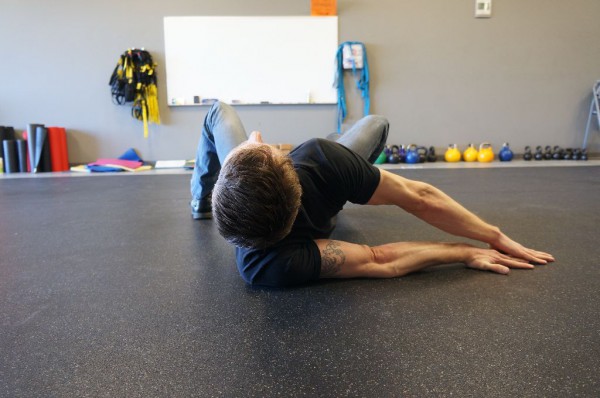http://pccblog.dragondoor.com/shoulder-opening-stretches/?utm_source=The+Rotater%27s+%22Top+10%22+Newsletter&utm_campaign=ae77dccdb6-The_Rotater_TOP_10_3_7_153_6_2015&utm_medium=email&utm_term=0_b069c819d0-ae77dccdb6-327172017
by BENJI WILLIFORD
by BENJI WILLIFORD
Continued progression toward getting stronger and improving performance requires a body that is “open” to the challenge. One of the biggest complaints that I consistently get from clients is about tight shoulders. It’s simple, you can’t move well if you can’t move. Some clients can’t hang from a bar without pain as they can’t even get their arms over their heads to get into position to do a pull-up; whereas other clients have a hard time in a plank to start push-ups without feeling neck pain (and everything in-between).
Opening up the shoulders and consequently the upper body will improve performance and help prevent injury. The shoulder joint is a ball and socket joint that really could be considered more of a ball and plate joint as it relies on the muscularity of the joint to keep it from dislocating. It is formed by the articulation of the head of the humerus with the scapula and is the most freely movable joint in the body. The main movements of the shoulder:
- Flexion-Lifting the arm forward in front of the body. The primary movers to this position are the anterior and medial deltoid, biceps brachii, coracobrachialis, and the upper pectoralis major.
- Extension-Pulling the arms back down and toward the back of the body. The primary movers are the latissimus dorsi and the teres major.
- Adduction-Holding the arms out and pulling them toward the midline of the body. The primary movers are the pectoralis major and the anterior deltoid.
- Adduction-Opening the arms away from the midline of the body. The prime mover is the posterior deltoid.
- External rotation-Holding the arms by the side, rotate the shoulders outward so that the palms are facing up and the thumbs are pointing to the back using the posterior deltoid, infraspinatus, and teres minor.
- Internal rotation- Holding the arms by the side, rotate shoulders inward so that the thumbs turn in toward the body using pectorailis major, latissimus dorsi, anterior deltoid, and the teres major.
Although shoulder movements can be placed in specific categories, exercises often times use combinations of those movements to complete a rep. For example in order to perform a muscle-up, the shoulders extend and external rotate to hold on to the bar. The shoulders will then go into flexion to pull the body to the bar and push the bar to the waist. Internal rotation also happens along the way. When looking at a get up, the shoulder will start in flexion with slight external rotation and will go through farther extension, abduction, internal rotation, external rotation, and extension again just to go from the floor to standing (1/2 the rep).
When stretching the shoulders, all of these movements should be taken into account in order to ensure that imbalances are fixed. The following video will demo a series of stretches that can be incorporated in a yoga practice, used for static stretches after a workout or any time after warming up the shoulders with some mobility work.
The additional benefits are that they will also open the chest, back, neck, and thoracic spine.
***
Benji Williford, PCC, RYT, CF-L1 is a Personal Fitness Trainer located out of Eau Claire, WI. Benji believes that, “A successful fitness program is based on positive dialogue between the mind and body.” He can be reached through his website: http://www.benjiwilliford.com/, or by email: Benji@ChainReaction-Fitness.com.

Комментариев нет:
Отправить комментарий